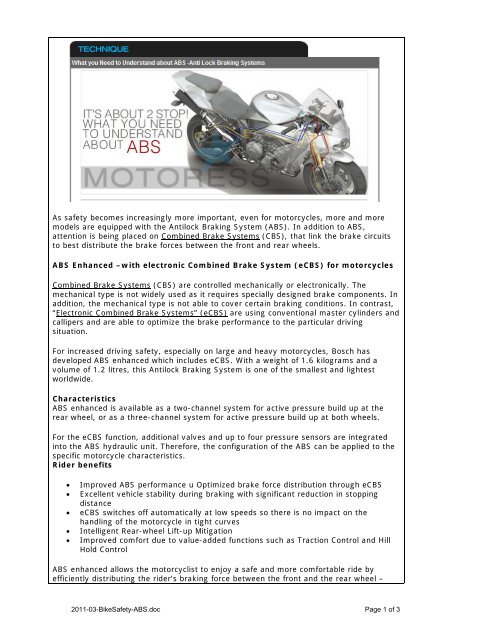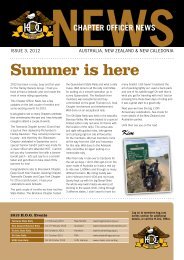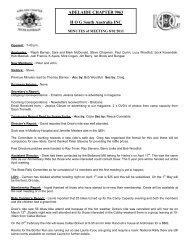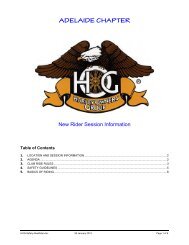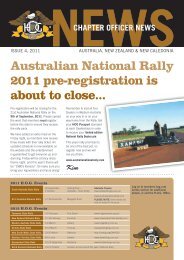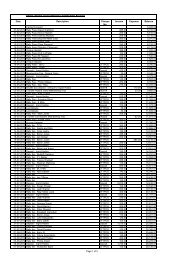with electronic Combined Brake System (eCBS) - Adelaide H.O.G.
with electronic Combined Brake System (eCBS) - Adelaide H.O.G.
with electronic Combined Brake System (eCBS) - Adelaide H.O.G.
You also want an ePaper? Increase the reach of your titles
YUMPU automatically turns print PDFs into web optimized ePapers that Google loves.
As safety becomes increasingly more important, even for motorcycles, more and more<br />
models are equipped <strong>with</strong> the Antilock Braking <strong>System</strong> (ABS). In addition to ABS,<br />
attention is being placed on <strong>Combined</strong> <strong>Brake</strong> <strong>System</strong>s (CBS), that link the brake circuits<br />
to best distribute the brake forces between the front and rear wheels.<br />
ABS Enhanced –<strong>with</strong> <strong>electronic</strong> <strong>Combined</strong> <strong>Brake</strong> <strong>System</strong> (eCBS) for motorcycles<br />
<strong>Combined</strong> <strong>Brake</strong> <strong>System</strong>s (CBS) are controlled mechanically or <strong>electronic</strong>ally. The<br />
mechanical type is not widely used as it requires specially designed brake components. In<br />
addition, the mechanical type is not able to cover certain braking conditions. In contrast,<br />
“Electronic <strong>Combined</strong> <strong>Brake</strong> <strong>System</strong>s” (eCBS) are using conventional master cylinders and<br />
callipers and are able to optimize the brake performance to the particular driving<br />
situation.<br />
For increased driving safety, especially on large and heavy motorcycles, Bosch has<br />
developed ABS enhanced which includes eCBS. With a weight of 1.6 kilograms and a<br />
volume of 1.2 litres, this Antilock Braking <strong>System</strong> is one of the smallest and lightest<br />
worldwide.<br />
Characteristics<br />
ABS enhanced is available as a two-channel system for active pressure build up at the<br />
rear wheel, or as a three-channel system for active pressure build up at both wheels.<br />
For the eCBS function, additional valves and up to four pressure sensors are integrated<br />
into the ABS hydraulic unit. Therefore, the configuration of the ABS can be applied to the<br />
specific motorcycle characteristics.<br />
Rider benefits<br />
<br />
<br />
<br />
<br />
<br />
Improved ABS performance u Optimized brake force distribution through eCBS<br />
Excellent vehicle stability during braking <strong>with</strong> significant reduction in stopping<br />
distance<br />
eCBS switches off automatically at low speeds so there is no impact on the<br />
handling of the motorcycle in tight curves<br />
Intelligent Rear-wheel Lift-up Mitigation<br />
Improved comfort due to value-added functions such as Traction Control and Hill<br />
Hold Control<br />
ABS enhanced allows the motorcyclist to enjoy a safe and more comfortable ride by<br />
efficiently distributing the rider’s braking force between the front and the rear wheel –<br />
2011-03-BikeSafety-ABS.doc Page 1 of 3
independent of which brake is activated. Measuring the rider‘s brake input and other<br />
parameters such as the speed, the system calculates the optimal brake force distribution<br />
in every braking situation.<br />
ABS enhanced improves the motorcycle stability and helps to shorten the stopping<br />
distance, even in case of panic braking <strong>with</strong> only the rear brake applied by the rider. This<br />
is how inexperienced riders can safely achieve maximum deceleration.<br />
In addition, ABS enhanced reduces suspension pitch. This minimizes inappropriate chassis<br />
reactions/motions and physical limits during braking can be utilized better.<br />
ABS enhanced features special software adaptations and different driving mode settings,<br />
e.g. sport or comfort mode. In addition, the system enables value added functions such<br />
as Traction Control and Hill Hold Control. The eCBS and ABS function can be switched off.<br />
Rear-wheel Lift-up Mitigation<br />
For some bikes, rear-wheel lift-up during emergency braking is almost inevitable due to<br />
the significant dynamic wheel-load changes. To counteract this effect, Bosch has<br />
developed the Rear-wheel Lift-up Mitigation function. ABS enhanced uses the information<br />
of the integrated pressure sensors in addition to the wheel speed sensor signals to judge<br />
the state of the vehicle at any time. If the ABS control unit detects that the rear wheel is<br />
about to lift up during braking, it adjusts the pressure in the front brake circuit to recover<br />
rear-wheel grip.<br />
Hill Hold Control<br />
Hill starts are not always easy, particularly when the motorcycle is heavy. The optional<br />
Hill Hold Control function prevents the motorcycle from accidentally rolling backward.<br />
Based on information from a longitudinal- acceleration sensor, Hill Hold Control identifies<br />
if the motorcycle is on a slope and at a standstill. After the rider has released the brake,<br />
the function automatically keeps the brakes applied for a moment. The rider can then<br />
start off <strong>with</strong>out rolling backward.<br />
Chassis <strong>System</strong>s Control ABS base/ABS plus–Antilock Braking <strong>System</strong>s for<br />
motorcycles<br />
Referring to the Bosch Antilock Braking <strong>System</strong> (ABS) for motorcycles assists the rider<br />
while braking in critical driving situations. The system prevents wheel lock-up and ensures<br />
bike stability as well as optimal deceleration while braking. ABS therefore significantly<br />
reduces the risk of falling and reduces stopping distance.<br />
Rider benefits:<br />
<br />
<br />
<br />
<br />
<br />
Product design specific for motorcycles, meets highest demands regarding box<br />
volume and weight<br />
Fits all vehicle classes, including small bikes and scooters<br />
High vibration resistance<br />
Increased comfort through excellent brake lever feel<br />
Intelligent Rear-wheel Lift-up Mitigation<br />
Bosch, the pioneer of ABS development, has offered Antilock Braking <strong>System</strong>s for<br />
motorcycles since 1994. Based on decades of experience, Bosch sets a new benchmark<br />
for motorcycle riding safety <strong>with</strong> the generation 9 of ABS for motorcycles.<br />
Characteristics<br />
In the past, Antilock Braking <strong>System</strong>s for motorcycles have typically been carried over<br />
from passenger cars, <strong>with</strong> little adaptation to motorcycle requirements. However,<br />
generation 9 of ABS base and ABS plus has been specifically designed to fulfil the<br />
motorcycle size and weight requirements. Compared to ABS generation 8, box volume<br />
and weight were reduced by half and the ABS software algorithm was modified to match<br />
2011-03-BikeSafety-ABS.doc Page 2 of 3
the newly downsized hardware. The optimized control of the electric motor for the return<br />
pump results in enhanced brake lever feel and improved noise behaviour.<br />
ABS base and ABS plus fulfil strict requirements regarding vibration resistance as the<br />
magnet valve coils and the printed circuit board are mounted directly on the hydraulic<br />
unit.<br />
Operating principle<br />
Speed sensors at both wheels register the rotational speed. If a wheel risks locking due to<br />
intense braking or slippery road conditions, the ABS hydraulic unit reduces the braking<br />
pressure applied by the rider and controls the wheel speed as well as the vehicle<br />
deceleration. This preserves the gyrostatic effect of the wheel and keeps the bike stable,<br />
even on varying surfaces. This is how the rider can safely achieve the shortest possible<br />
stopping distance.<br />
The generation 9 ABS systems are modular and scalable. They also feature a dedicated<br />
control strategy for each vehicle class, such as cruisers, sport bikes, scooters or mopeds.<br />
ABS base, the basic ABS version for motorcycles, offers proven protection against the<br />
locking of the wheels during braking and is suitable for all powered two wheelers <strong>with</strong><br />
hydraulic front- and rear-wheel brakes. ABS plus, in addition, contains an integrated<br />
pressure sensor to fulfil the highest demands in the detection and mitigation of rear-wheel<br />
lift-up. ABS plus enables enhanced vehicle stability during extreme stopping manoeuvres.<br />
This makes it especially suitable for high performance bikes such as sports and super<br />
sport bikes.<br />
Rear-wheel Lift-up Mitigation<br />
For some bikes, rear-wheel lift-up during emergency braking is almost inevitable due to<br />
the significant dynamic wheel-load changes. To counteract this effect, Bosch has<br />
developed the Rear-wheel Lift-up Mitigation function.<br />
While ABS base provides a basic protection against rear-wheel lift-up, ABS plus offers<br />
enhanced rear-wheel lift-up protection using the information of the integrated pressure<br />
sensor in addition to the wheel-speed sensor signals to judge the state of the vehicle at<br />
any time. If the ABS control unit detects that the rear wheel is about to lift up during<br />
braking, it adjusts the pressure in the front brake circuit to recover rear wheel grip.<br />
2011-03-BikeSafety-ABS.doc Page 3 of 3


